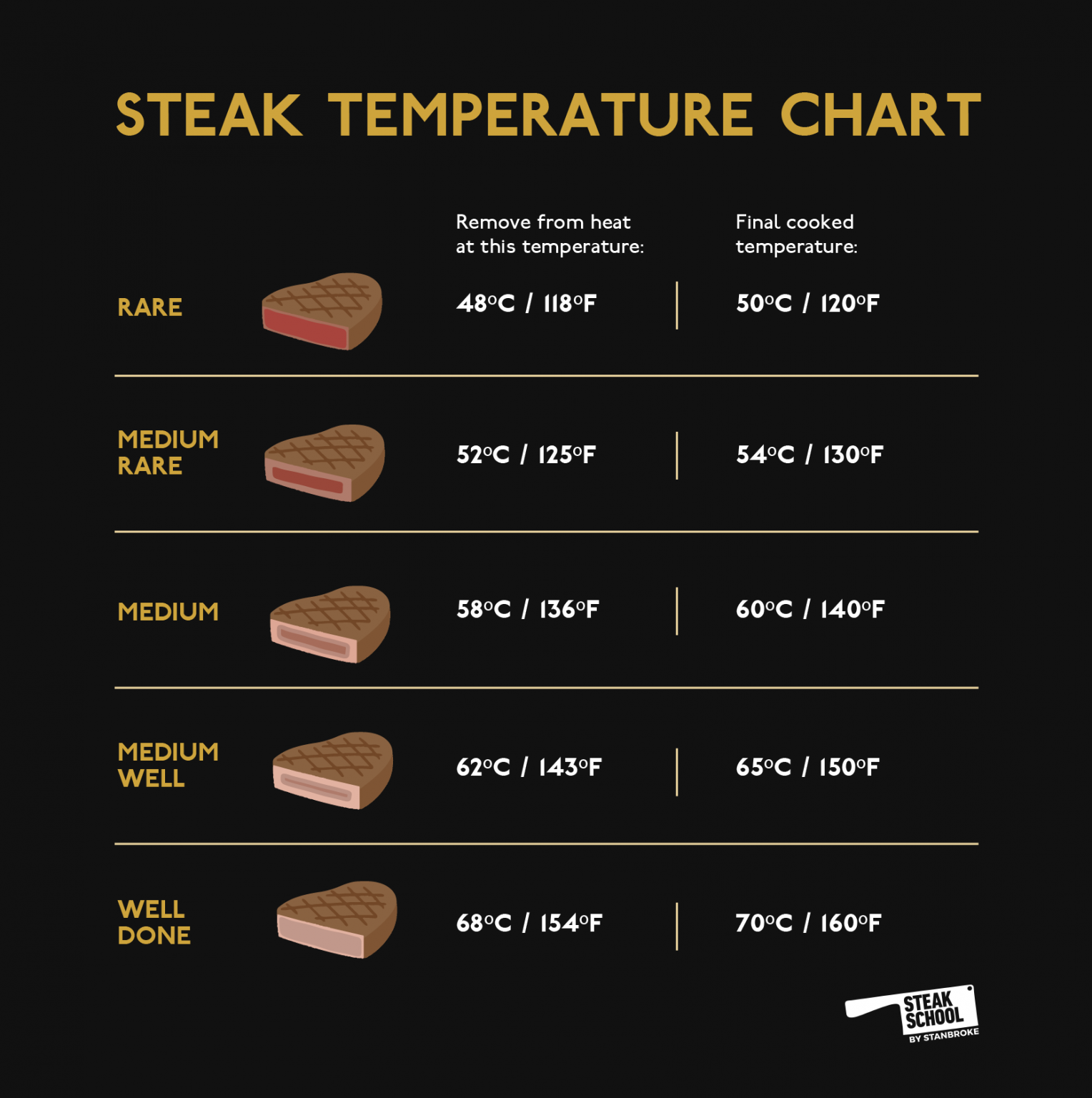Master Steak Doneness: Temperatures & Guide + Tips
Is achieving the perfect steak doneness a culinary quest you've undertaken? Mastering the art of steak cookery, transforming a simple cut of meat into a symphony of flavor and texture, hinges on understanding internal temperatures.
The journey to steak perfection begins with a simple tool: a meat thermometer. This humble instrument is your key to unlocking a world of culinary possibilities, allowing you to precisely control the internal temperature of your steak and achieve your desired level of doneness. From the barely-seared rare to the thoroughly cooked well-done, each temperature represents a unique textural and flavor profile. Armed with a thermometer, you're no longer guessing; you're crafting.
The following table provides a clear guide to the internal temperatures associated with various steak doneness levels. Remember that these temperatures are crucial, but they are not the only factor. The quality of the cut, the cooking method, and the resting time all play important roles in the final result. Don't hesitate to experiment and fine-tune your approach to find your personal steak nirvana.
| Doneness | Internal Temperature (F) | Characteristics |
|---|---|---|
| Rare | 125-130F | Warm red center with more browning on the edges; Soft in the center with firm edges. |
| Medium Rare | 130-140F | Light pink center with a thicker ring of brown; Soft in the center with firm edges. |
| Medium | 140-150F | Light brown with a touch of pink in center; Soft in the center with firm edges. |
| Medium Well | 150-155F | Mostly brown center and firm texture; Just a hint of pink in the center. |
| Well Done | 160F and above | Brown all the way through. |
To achieve these temperatures, youll need to understand the concept of carryover cooking. This refers to the continued rise in internal temperature after you remove the steak from the heat source. As a general rule, remove the steak from the heat a few degrees below your target temperature to allow for carryover cooking. The final temperature should be 135 for medium rare, and remove the steak from heat when the internal temp reaches 145F for a 150F target temperature.
Consider medium rare, often the favored doneness in restaurants, unless you have specific preferences. It's where the steak sings the right balance of tenderness, flavor and juiciness. Cook for 6 minutes, flip and cook for an additional 6 minutes, or until your desired temperature is reached.
However, medium well, while a popular request, is not my recommended doneness. When you cook a steak past 150F, it gets dry. I often recommend having a cutoff temperature at medium to ensure your steak remains juicy and moist.
- Alice Rosenblum Onlyfans Photos Videos More Latest Updates
- David Muirs Private Life Dating Rumors Relationships Explored
A meat thermometer is your most reliable ally. With it, you can ensure your steak is cooked to the exact level of doneness you prefer. Whether it's rare, medium rare, medium, medium well, or well done, the thermometer ensures a consistent, predictable result.
The USDA recommends a safe internal temperature of 145F (63C) for steak. This is the minimum temperature needed to kill bacteria. However, for those who are elderly or immunocompromised, it's best to err on the side of caution and cook the steak to a higher temperature.
Resting is crucial. Remove the steaks from the heat, and let them rest for five to ten minutes before slicing. This allows the juices to redistribute throughout the meat, resulting in a more tender and flavorful steak. This is also a good time to remove any metal skewers.
The final temperature should be the holy grail. Aim for 140 to 150F, and consider that the Ribeye, with its high fat content, is least likely to dry out. When done, serve.
Grilling a steak, the process of achieving the perfect crust and flavor, also benefits from temperature control. The grilling times and temperature for steak depend on your desired doneness. For example, some recommend 5 then 3 minutes per side, or 5 then 4 minutes per side.
Consider the cooking process, in particular the time, temperature, and method of cooking can be adapted for different results.
The steak temperature chart is a visual representation of the information about the required temperatures for how long you want your steak to be cooked.
With a little practice and patience, you can consistently cook steak to your desired level of doneness, transforming your kitchen into a gourmet steakhouse. So, grab your meat thermometer, fire up the grill or skillet, and embark on your steak-cooking journey!



Detail Author:
- Name : Roxanne Cartwright
- Username : kuvalis.linda
- Email : malika.moore@hotmail.com
- Birthdate : 1976-11-05
- Address : 7891 Flatley Haven New Clint, AK 87232
- Phone : 1-858-869-9806
- Company : McCullough LLC
- Job : Social Worker
- Bio : Et laborum aut laboriosam et quo quia. Explicabo corporis tenetur impedit molestias blanditiis et deserunt autem. Nobis aut molestiae aut.
Socials
tiktok:
- url : https://tiktok.com/@violetfeest
- username : violetfeest
- bio : Sunt debitis reprehenderit minima et deserunt tempore.
- followers : 2751
- following : 157
facebook:
- url : https://facebook.com/violet_feest
- username : violet_feest
- bio : Quae voluptate minus nesciunt tenetur recusandae quibusdam quia.
- followers : 6767
- following : 1775